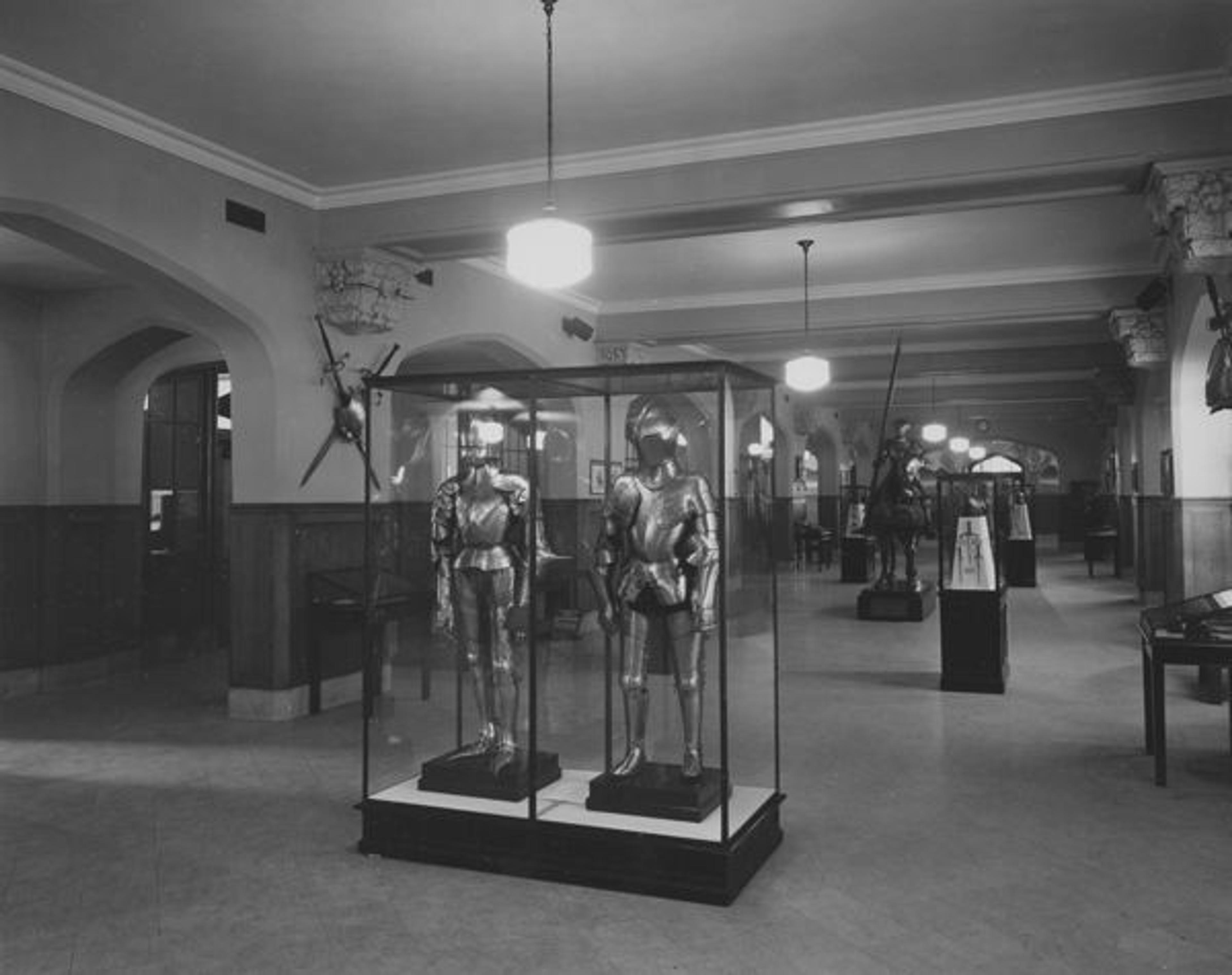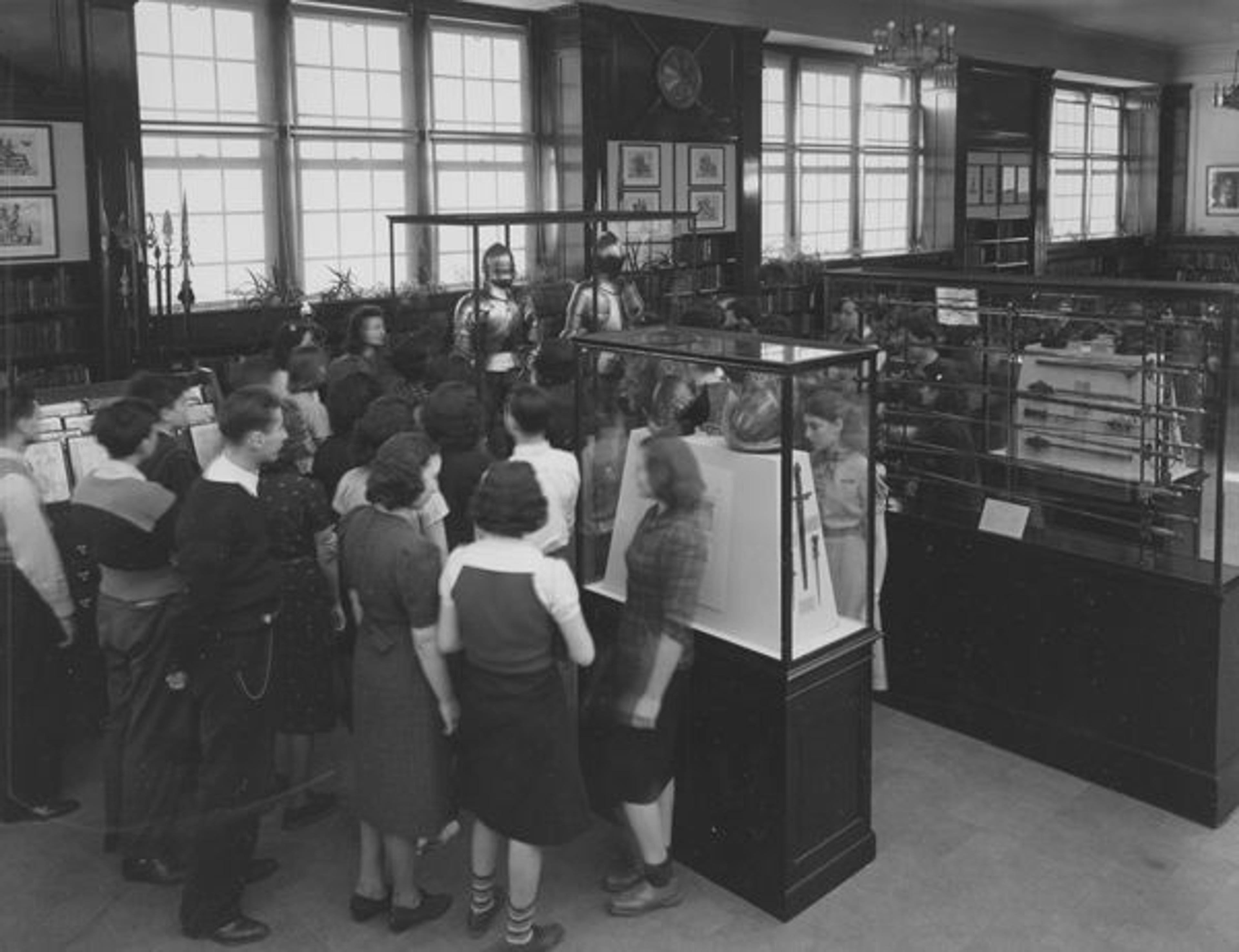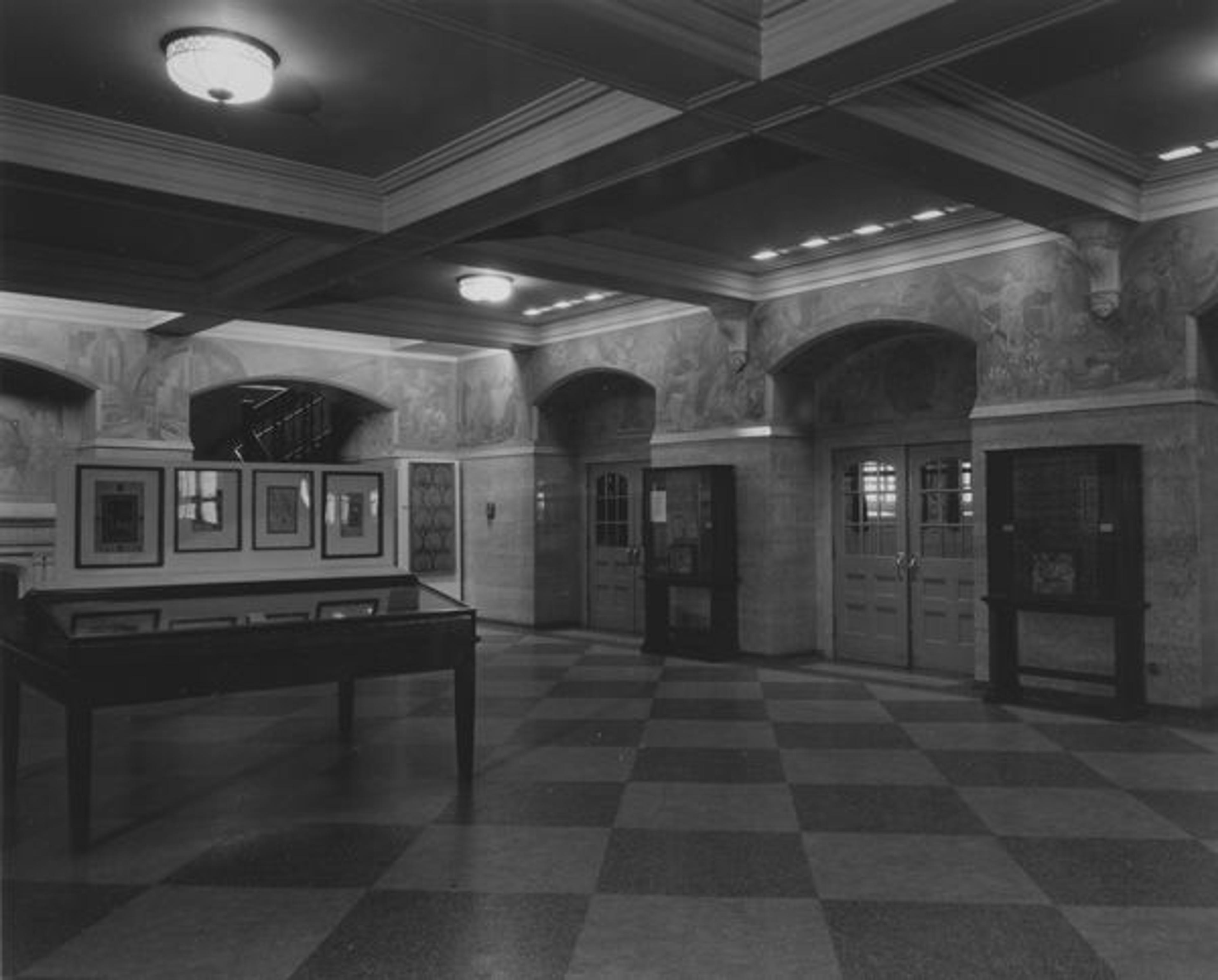
College of the City of New York (New York, New York): Arms and Armor (through September 6, 1939). Photographed July 7, 1939. See slideshow
«Beginning in 1933, in the shadow of the Great Depression, the Museum began an initiative known as "Neighborhood Circulating Exhibitions." This experiment was a collection of traveling exhibitions, composed exclusively of Museum-owned objects, to be exhibited in the neighborhoods of "certain groups in the city's population that have not thus far had the adequate opportunity to take advantage of the Museum's services" (The Metropolitan Museum of Art Bulletin, Vol. 28, No. 11, Part 1, Nov. 1933, 183). The works were to be exhibited, at the expense of the Museum, in neighborhood spaces such as settlement houses, branches of the New York Public Library, municipal offices, and schools.»
The initial exhibitions were as dynamic as those of today and featured a variety of themes that spanned the globe: China and Japan: An Exhibition of Far Eastern Art; Arms and Armor, Textiles, and Costume Dolls, 1492–1776: An Exhibition of European Art; and Ancient Egypt: Its Life and Art. The collections were to be shown in six-week installments between November 6, 1933, and April 15, 1934, in the University Settlement at Rivington and Eldridge Streets; the Hudson Guild on 27th Street, between Ninth and Tenth Avenues; and at the Hudson Park Branch Library of the New York Public Library, Seventh Avenue and Leroy Street, under the auspices of Greenwich House (The Metropolitan Museum of Art Bulletin, Vol. 28, No. 11, Part 1, Nov. 1933, 183; and The Metropolitan Museum of Art Bulletin, Vol. 29, No. 2, Feb. 1934, 36).
In connection with the Arms and Armor, Textiles, and Costume Dolls, 1492–1776 exhibition, two Museum-produced movies were also shown: A Visit to the Armor Galleries and Firearms of Our Forefathers, which were shown twice daily, at 4:00 (expressly for children) and 8:00 p.m. The total number of visitors to the circulating exhibitions was 82,332, with daily averages varying from 456 to 64, depending upon the location; the total attendance for the movies was 14,577 (The Metropolitan Museum of Art Bulletin, Vol. 29, No. 5, May 1934, 85).
This initial experiment proved to be a huge success and was expanded upon over the next nine years. Additional exhibition themes and locations were added, and attendance figures rose to 1,503, 091 by the end of 1938. Several months later, by the end of May 1939, an additional seven exhibitions in seven different locations were added, with attendance figures of 76,002 recorded for 263 exhibition days. Over the course of 1938, instructors gave no less than 1,079 gallery talks attended by 22,439 visitors—all of which were free during the local institution's hours, "which [meant] an exhibition day as long as thirteen hours and frequently include[d] Sundays" (The Metropolitan Museum of Art Bulletin, Vol. 34, No. 6, Jun. 1939, 152).

Theodore Roosevelt High School (The Bronx, New York): Arms and Armor (opened February 9, 1939); With teacher and students visiting the exhibition. Photographed February 1939
Five years after the first exhibition circuit, the Director of the Department of Industrial Relations, Richard F. Bach, elucidated upon on the impetus and impact of these exhibitions. The impetus was purely altruistic: Quite simply, if certain New York City residents could not come to the Museum, then the Museum would come to them. The Met's goal was to make the collection available in the far reaches of the city, and "to persons prevented from visiting the Museum by heavy schedules of work and study." Over those 5 years, the Museum installed 1,500 objects in 50 exhibitions across 27 locations throughout 4 of the city's boroughs.
Bach felt firmly justified in the expense: "We may now regard [these circulating exhibitions] as an accepted form of Museum extension, a simple and direct means of meeting the obligation placed upon all museums to extend their service to the maximum radius in the cities from which they receive support . . . It is by such extension activity that our citizens in always increasing numbers may gain the conviction that the Metropolitan Museum is their Museum" (The Metropolitan Museum of Art Bulletin, Vol. 33, No. 11, Part 1, Nov. 1938, 252). The exhibitions were so successful that they were featured in radio programs and other media, receiving the nicknames "Caravans of Art" and "Museum on the March" (The Metropolitan Museum of Art Bulletin, Vol. 33, No. 11, Part 1, Nov. 1938, 251).
While the exhibitions were touring, they were supplemented by a staff of instructors and guards furnished by the Works Progress Administration. However, despite this contribution, the expense to the Museum was enormous—so much so that, between 1939 and 1942, the tone of the yearly updates made by Bach in the Museum's Bulletin shifted dramatically from one of idealistic optimism to overwhelming fiscal realism. Bach outlined in his report that the Museum had "met the entire cost of transportation, insurance, installation, skilled labor, night watchmen, and the usual office responsibilities in various departments, such as those of the Director, Secretary, Superintendent, Treasurer, Registrar, and the curatorial departments involved" (The Metropolitan Museum of Art Bulletin, Vol. 34, No. 6, Jun. 1939, 152). In June 1942, the Museum announced the suspension of the WPA project, and without its integral assistance, the Museum's extension activities were officially suspended on April 30, 1942.

Textile High School (New York, New York): Art of the Near East (on view February 3–May 6, 1937). Photographed February 6, 1937
Exhibitions Produced in the Neighborhood Circulating Exhibition Series
Ancient Egypt: Its Life and Art
Ancient Greece and Rome
Arms and Armor, Textiles, and Costume Dolls, 1492–1776: An Exhibition of European Art
Arms and Armor
Art of China
Art of the Near East
The Art of Japan
China and Japan: An Exhibition of Far Eastern Art
European Textiles and Costume Figures
Oriental Prints and Textiles
A Selection of Known Exhibition Locations (All Locations in Manhattan, unless Otherwise Noted)
Bronx County Building, Concourse at 161st Street, The Bronx
Bronx Union Branch, YMCA, East 161st Street and Washington Avenue, The Bronx
College of the City of New York, 139th Street and Covent Avenue
De Witt Clinton High School, Mosholu Parkway and Sedgwick Avenue, The Bronx
Educational Alliance, East Broadway and Jefferson Street
Fordham Branch, New York Public Library, 2556 Bainbridge Avenue, The Bronx
George Bruce Branch Library, New York Public Library, 518 West 125th Street
George Washington High School, Audubon Avenue and 192nd Street
High Bridge Branch, New York Public Library, Woodycrest Avenue and 168th Street, The Bronx
Hudson Park Branch Library, Seventh Avenue and Leroy Street
Hunter College, Bedford Park Boulevard and Navy Avenue, The Bronx
James Monroe High School, East 172nd Street and Boynton Avenue, The Bronx
Morris High School, Boston Road and 166th Street, The Bronx
New York School of Fine and Industrial Arts, 257 West 40th Street
Seward Park High School, Grand and Essex Streets
Staten Island Institute of Arts and Sciences, Stuyvesant Place, St. George, Staten Island
Teachers College Library, West 120th Street
Textile High School, 18th Street, east of Ninth Avenue
Theodore Roosevelt High School, East Fordham Road and Washington Avenue, The Bronx
Union Settlement, 237 East 104th Street
University Settlement, Eldridge and Rivington Streets
Washington Heights Branch Library, 1000 St. Nicholas Avenue
Washington Irving High School, Irving Place at 16th Street
Related Link
View a slideshow of archival images related to this post.